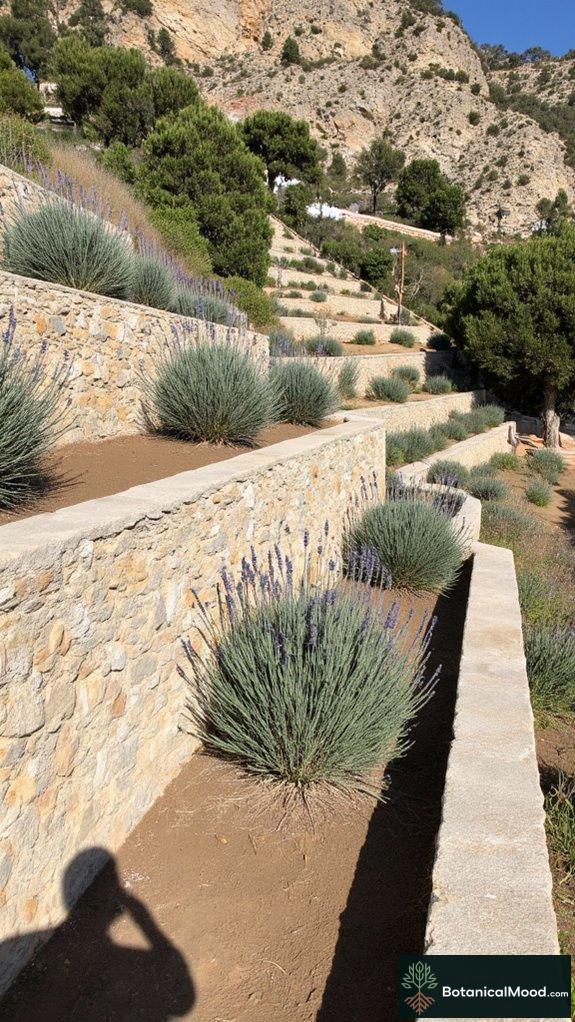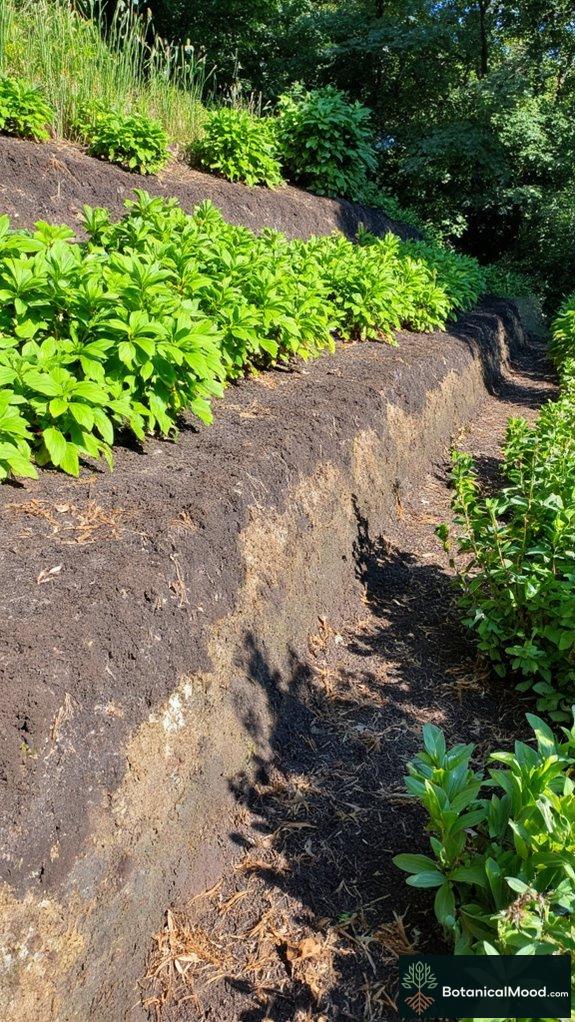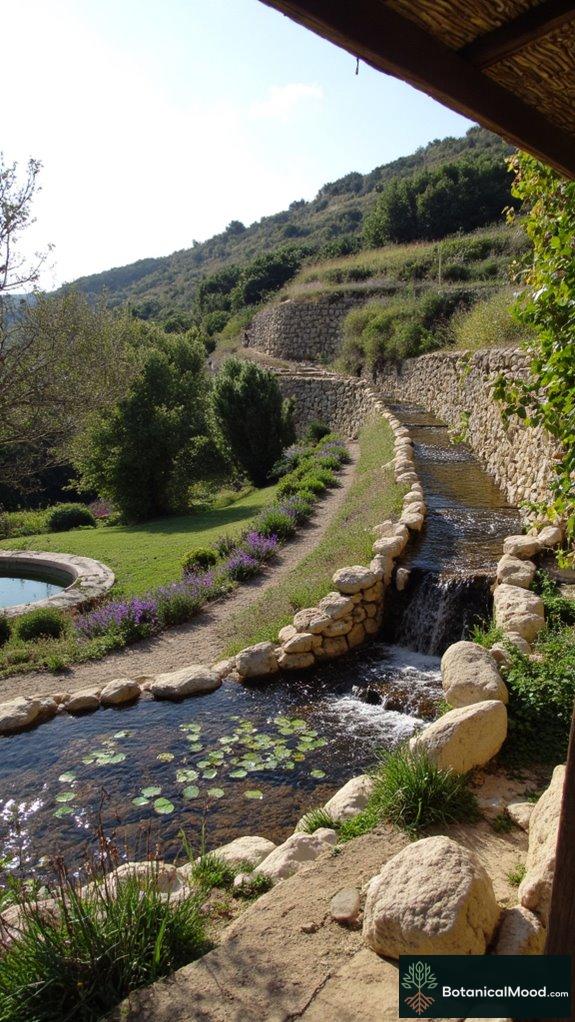Ever tried creating a hillside garden? It’s like being a sculptor, but instead of marble, I’m playing with *Salvia clevelandii* and *Eriogonum fasciculatum*.
I remember my first slope—let’s just say it didn’t end well. Terracing with local stone seemed promising until I realized my retaining walls resembled a toddler’s building blocks. Not my best work, folks!
But organic compost? Oh, that changed everything! Rich soil, inviting pathways, and those tranquil water features? Pure magic. Who knew gardening could feel like a peaceful walk in nature?
Have you ever felt that rush of creating something beautiful? Trust me; hillside designs are worth the challenge!
My Experience with Small Space Garden Design
One summer, I tackled a tiny balcony that was practically screaming for life. Armed with thrifted terracotta pots and a mishmash of drought-tolerant plants, I went into overdrive. Every inch mattered!
The result? A mini oasis bursting with color. I added a quirky, little solar-powered fountain—because why not? Birds showed up out of nowhere, feeling right at home. Who knew my little project would attract wildlife? Exciting moments like that remind me why garden design truly sets my soul on fire. Whether it’s maximizing space or incorporating native species, the joy is in the journey!
Quick Takeaways
- Integrate drought-tolerant native plants like *Salvia clevelandii* to enhance hillside resilience and aesthetic appeal.
- Utilize terracing techniques with local stone retaining walls to create functional and visually appealing garden spaces.
- Enhance soil quality with organic compost and mulch to promote vibrant plant growth and reduce erosion.
- Design pathways using natural stone or permeable pavers to create inviting journeys through sloped gardens.
- Incorporate water features like reflecting ponds or rill streams to add tranquility and visual interest to the garden.
Embracing Drought-Tolerant Plants for Hillside Beauty

When designing a hillside garden, embracing drought-tolerant plants isn’t just a practical choice; it’s a pathway to creating a stunning setting that thrives in our changing climate.
Utilizing xeriscaping techniques, I focus on incorporating native species like *Salvia clevelandii* and *Eriogonum fasciculatum*, which not only endure minimal water but also support local wildlife. These resilient plants tastefully blend textures and colors, enhancing the hillside’s natural beauty while ensuring safety and sustainability.
I’ve realized that cultivating a setting with these choices aids in soil erosion control, providing stability that we all desire for our homes. Additionally, it’s essential to consider coastal garden design elements that can enhance the overall resilience of the landscape against climate challenges.
With careful planning and a passion for the earth, my hillside garden has become a reflection of nature’s art—an inviting sanctuary for all.
The Art of Terracing: Techniques and Materials

How can terracing transform a hillside garden into a visually striking and functional space?
By incorporating well-designed terraces, I’ve found it possible to create levels that not only enhance aesthetics but also improve safety, thanks to effective gravity retention strategies.
Using retaining walls crafted from local stone or interlocking blocks offers both support and visual appeal, while soil stabilizers help prevent erosion, ensuring the ground remains secure.
Integrating plants like Lavandula angustifolia or Rosmarinus officinalis between the terraces adds beauty and prevents soil displacement. Additionally, sustainable terracing techniques promote biodiversity by encouraging the growth of native plants that thrive in sloped environments.
The practical aspect of terracing aligns perfectly with my vision of a sustainable garden, where beauty meets functionality, allowing me to cultivate a serene retreat that’s as safe as it’s stunning.
Enhancing Soil Quality for Resilient Growth

While nurturing a hillside garden, I’ve discovered that enhancing soil quality is pivotal for resilient growth and vibrant plant life. To achieve this, I incorporate key elements that substantially boost my garden’s health:
- Organic compost: This enriches the soil with essential nutrients, promoting beneficial microorganisms.
- Soil amendments: Products like peat moss or perlite improve aeration and drainage, essential for preventing root rot.
- Mulch: Provides a protective layer, conserves moisture, and reduces erosion on sloped terrains.
- Regular testing: It helps identify pH levels and nutrient deficiencies, allowing for targeted amendments.
Creating Inviting Pathways Through Sloped Gardens

Creating inviting pathways through sloped gardens transforms a functional necessity into an aesthetic feature that enhances the overall experience of the space.
I choose pathway materials like natural stone or permeable pavers, not just for their beauty but also for their safety. When traversing slopes, a textured surface minimizes the risk of slipping, ensuring a secure footing.
Consider using robust plants like Lavandula angustifolia or Rosmarinus officinalis alongside these paths to create a sensory experience.
Proper slope traversal involves strategic placement, gently weaving the pathways through the garden, directing visitors while showcasing the lush vegetation.
Integrating Water Features for Serenity and Aesthetics

Integrating water features into sloped gardens not only enhances the visual appeal but also creates an atmosphere of tranquility that invites reflection and relaxation.
I can’t stress enough how a well-placed fountain or pond can stir feelings of waterfall serenity while providing tranquil reflections amidst lush greenery.
Here are a few ideas to contemplate:
- Miniature Waterfalls: These create stunning focal points, cascading water offers soothing sounds.
- Reflective Ponds: They mirror the sky and surrounding plants, enhancing your garden’s beauty.
- Rill Streams: Narrow channels can meander down slopes, leading to a natural flow.
- Water Plants: Incorporating *Nymphaea* (water lilies) softens edges, adding color and life.
Crafting Outdoor Living Spaces in Elevated Areas

Elevated areas in gardens present unique opportunities for crafting intimate outdoor living spaces that harmonize with nature’s contours.
When designing these spaces, I focus on incorporating durable outdoor furniture, like weather-resistant aluminum or teak, which blends seamlessly with the surroundings.
I always seek natural shade from trees such as Quercus ilex (Holm Oak) or Platanus orientalis (Oriental Plane) to create a cool, inviting atmosphere.
Arranging the furniture in intimate clusters not only encourages conversation but also provides an open feel, essential for safety in multi-level gardens.
Adding soft textiles can enhance comfort, while decorative stone pathways guide movement through the garden without compromising stability.
Creating these elevated outdoor spaces inspires tranquility, allowing me to enjoy nature’s beauty with confidence and ease.
Seasonal Interest: Year-Round Structure in Garden Design

While gardens often evoke images of splendor in full bloom during the warmer months, the true artistry of garden design lies in crafting spaces that maintain interest and structure year-round.
To achieve this, I focus on incorporating elements that provide year-round color and seasonal textures. Here are some strategies I find effective:
- Choose evergreens like Ilex aquifolium and *Pinus mugo* for consistent structure.
- Integrate perennials such as Echinacea purpurea and *Sedum spectabile* for finishing touches throughout different seasons.
- Utilize hardscaping with stones or decorative tiles for added stability and beauty.
- Select plants with varying bark textures, like Betula pendula for visual intrigue in winter.
Creating diverse layers truly transforms hillside gardens into enchanting spaces year-round.
Sustainable Practices for Mediterranean Gardens

Creating a Mediterranean garden opens up a world of possibilities for cultivating sustainability while embracing the region’s iconic aesthetic.
By incorporating native plant selection, I create a thriving environment that thrives without excessive resources. Utilizing plants like *Lavandula angustifolia* (English lavender) and *Rosmarinus officinalis* (rosemary) not only enhances biodiversity but also minimizes water consumption.
To further promote sustainability, I implement eco-friendly irrigation methods, such as drip irrigation and rainwater harvesting. This guarantees our gardens remain lush while reducing water waste.
Here’s a neat overview of sustainable practices:
| Practice | Benefits | Examples |
|---|---|---|
| Native Plant Selection | Reduced water and maintenance needs | *Lavandula angustifolia*, *Santolina chamissonis* |
| Eco-Friendly Irrigation | Water conservation and efficient watering | Drip systems, rain barrels |
| Composting | Improves soil health | Kitchen scraps, yard waste |
| Mulching | Conserves moisture and suppresses weeds | Wood chips, straw |
Inspiring Plant Combinations for Visual Impact

How can we transform our gardens into visually stunning environments while ensuring they’re harmonious with the natural surroundings? I believe the secret lies in combining plants that provide colorful blooms and contrasting textures.
Here are four combinations that can elevate your hillside garden’s appeal:
- Lavender (Lavandula) interspersed with Silver Dust (Dusty Miller) for aromatic beauty and silvery foliage
- Salvia (Salvia officinalis) alongside Sedum (Sedum spectabile) for vibrant color contrast and low maintenance
- Echinacea (Echinacea purpurea) paired with Ornamental Grasses (Miscanthus sinensis) for dynamic height variation and movement
- Geranium (Geranium sanguineum) mingled with Rockrose (Cistus) for a riot of color and delightful textures
These thoughtful combinations not only enhance visual interest but also promote a safe, sustainable setting that supports local wildlife.
Innovative Water Features Integration

Integrating innovative water features into Mediterranean hillside gardens not only enhances aesthetic appeal but also fosters functionality that aligns with our environment. A well-placed freestanding fountain or a modest wall-mounted fountain can beautifully accentuate the unique contours of the land while providing a pleasant auditory backdrop, essential for an enjoyable outdoor experience. Consider pondless waterfalls, which craft a naturalistic flow without standing water, minimizing mosquito risks and enhancing wildlife habitats. Utilizing recirculating systems contributes to water conservation, ensuring sustainability in garden design.
Birdbaths attract avian guests, promoting biodiversity essential for ecological balance. These elements work together to create not just beauty, but also a cooling microclimate, offering us delightful refuge on those hot Mediterranean days, all while remaining safe and responsible in our design choices.
Terraced Planting for Erosion Control

Terraced planting serves as an effective solution for managing erosion while enhancing the beauty of Mediterranean hillside gardens. By creating level planting areas, we can notably reduce soil erosion and maintain soil stability.
Here are some key benefits of terraced planting:
- Breaks large slopes into smaller, less steep segments to slow runoff
- Anchors soil with plant roots, diminishing slide risks
- Creates microclimates for diverse crop success
- Requires minimal maintenance with annual inspections for erosion signs
Additionally, proper terrace maintenance involves inspecting structures after storms to prevent erosion.
With thoughtful plant selection, such as native species like Salvia nemorosa or creeping phlox (Phlox subulata), you can further enhance both stability and aesthetic appeal in your hillside gardens.
Meet the Visionary Designer

Laura Johnson, from Santa Barbara, California, envisioned her hillside garden as a serene retreat, drawing inspiration from her childhood memories of Mediterranean scenery during family travels across Europe.
To bring her vision to life, Laura collaborated with experienced site designers specializing in Mediterranean climates. The design process involved thorough consultations, site analyses, and the careful selection of native plants, ensuring a sustainable and harmonious garden that integrates seamlessly with the surrounding hillside topography.
Using tools like soil augers and garden trowels, Laura implemented her design with natural materials from brands like Elbow Grease and EcoGarden.
She worked alongside horticulturists from the local nursery, Lotus Gardens, to select drought-resistant species such as lavender and euphorbia, enriching her idyllic space.
Renowned Hillside Garden Designs

While hillside gardens offer unique challenges due to their steep terrains, they also provide an incredible opportunity for creativity and beauty, allowing designers to marry form and function in spectacular ways.
In renowned hillside garden designs, I appreciate the incorporation of slope solutions such as retaining walls, terraces, and meandering paths that enhance both hillside aesthetics and functionality.
Using drought-tolerant native plants like *Sedum* and *Yarrow* not only guarantees sustainability but also promotes biodiversity.
I find outdoor living spaces, crafted with natural materials like wood and stone, to harmonize beautifully with the topography, while water features, such as fountains, bring tranquility.
Summary
Transforming hillside gardens into beautiful spaces is all about using drought-resistant plants and smart terracing. Neatly placed paths and soothing water features turn these areas into living stories of sustainability. I invite you to discover your garden’s potential and explore beauty in every curve of the slope.
I’d love to hear about your experiences with hillside gardening. What challenges have you faced?
Feel free to share pictures of your own garden and tell us about how you designed it!
References
- https://raleighrealty.com/blog/gardening-statistics-trends
- https://www.gardendesign.com/landscape-design/mediterranean.html
- https://www.mediterraneangardensociety.org/journal6.pdf
- https://www.mediterraneangardensociety.org/109-hillside.html
- https://www.finegardening.com/article/a-dry-mediterranean-garden
- https://www.melaniejadedesign.com/create-a-mediterranean-garden/
- https://pacifichorticulture.org/articles/gardeners-guide-to-the-mediterranean-climate/
- https://www.ishs.org/ishs-article/881_13
- https://www.acsgarden.com/articles/other-gardening/mediterranean-gardens.aspx
- https://www.homesandgardens.com/gardens/mediterranean-garden-ideas
- https://www.houzz.com/photos/hillside-water-fountain-landscape-ideas-phbr2-bp~t_728~a_34-235–38-255
- https://petruslandscape.com/mediterranean-landscape-design-ideas/
- https://www.houzz.com/photos/mediterranean-water-fountain-landscape-ideas-phbr2-bp~t_728~s_2109~a_34-235
- https://waterwisegardenplanner.org/garden-designs/mediterranean-garden/
- https://pacifichorticulture.org/articles/the-mediterranean-garden-image-style-or-cultural-expression/
- https://dirtlocker.com/blogs/blog/transform-your-spring-garden-how-terracing-with-dirt-locker-can-solve-common-landscaping-problems
- https://eos.com/blog/terrace-farming/
- https://supremeenterprisesllc.com/erosion-control/erosion-control-plants/
- https://www.extension.purdue.edu/extmedia/ae/ae-114.html
- https://tahoebmp.org/Documents/BMPHandbook/Chapter 4/4.2/e_Terrac.pdf

Leave a Reply